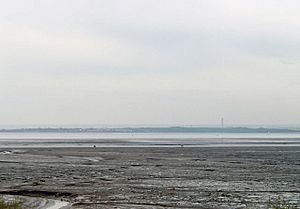Benfleet and Southend Marshes facts for kids
| Site of Special Scientific Interest | |
 |
|
| Area of Search | Essex |
|---|---|
| Interest | Biological |
| Area | 2099.7 hectares |
| Notification | 1987 |
| Location map | Magic Map |
|
Designations
|
|
| Official name: Benfleet & Southend Marshes | |
| Designated: | 14 February 1994 |
|---|---|
| Reference #: | 648 |
Benfleet and Southend Marshes is a very special natural area in Essex, England. It covers a huge space, about 8.1 square miles (2099.7 hectares)! This amazing place is made up of mudflats, salty marshes, bushy areas, and wild grassy fields. It even includes the beach area along Southend-on-Sea. It's important because it's a fantastic home for many different plants and animals.
Contents
What are Benfleet and Southend Marshes?
This area is recognized as a Site of Special Scientific Interest (SSSI). This means it's a place with very important plants, animals, or geology. For Benfleet and Southend Marshes, it's all about the amazing wildlife and ecosystems.
The entire area is also part of a larger protected zone. This zone is called a Ramsar site and a Special Protection Area. These names mean it's important for nature on an international level.
Leigh National Nature Reserve
In the middle-west part of the marshes, there's an even more protected spot. This is the Leigh National Nature Reserve (NNR). A National Nature Reserve is a special place set aside to protect wildlife and habitats. It's considered very important for nature across the country.
Part of this reserve includes the eastern half of Two Tree Island. This island is located in Leigh-on-Sea. The Essex Wildlife Trust helps to look after this part of the reserve.
Southend on Sea Foreshore
Most of the Benfleet and Southend Marshes is also known as the Southend on Sea Foreshore. This part is a Local Nature Reserve. A Local Nature Reserve is a place that is important for nature in a local area. It's also a great place for people to enjoy nature.
Home to Amazing Wildlife
The marshes and mudflats here are super important for birds. They are a vital stop for many wildfowl and wading birds. These birds come here from all over the world.
You can see huge numbers of birds like the dark-bellied brent goose. Other birds include the grey plover, redshank, and red knot. These birds rely on the marshes for food and a safe place to rest.
Rare Insects
The marshes are also home to some rare insects. These insects have special ways of living that fit perfectly with the marsh habitats. For example, you might find the white-letter hairstreak butterfly. Another special butterfly here is the marbled white. These insects add to the amazing variety of life in the marshes.

